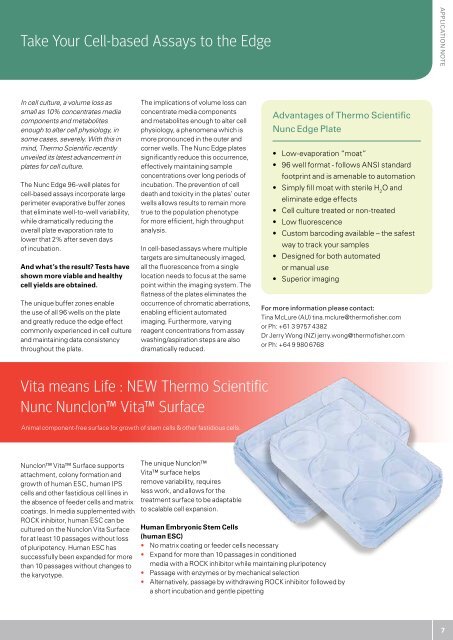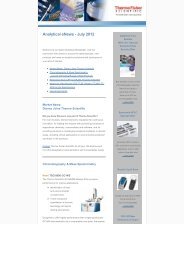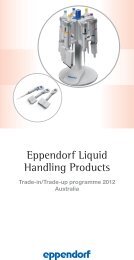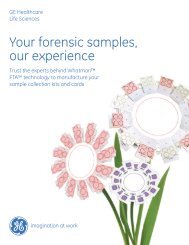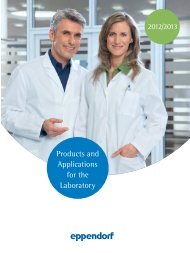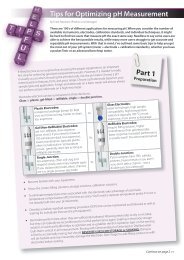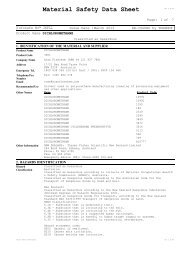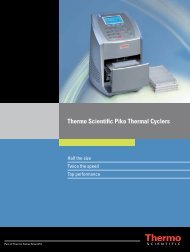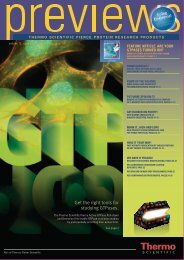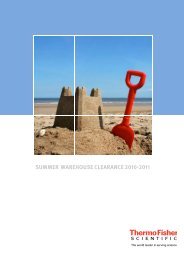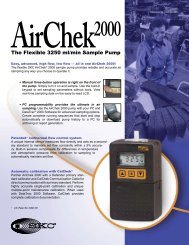Issue 1 - Thermo Fisher
Issue 1 - Thermo Fisher
Issue 1 - Thermo Fisher
Create successful ePaper yourself
Turn your PDF publications into a flip-book with our unique Google optimized e-Paper software.
Take Your Cell-based Assays to the Edge<br />
Application Note<br />
In cell culture, a volume loss as<br />
small as 10% concentrates media<br />
components and metabolites<br />
enough to alter cell physiology, in<br />
some cases, severely. With this in<br />
mind, <strong>Thermo</strong> Scientific recently<br />
unveiled its latest advancement in<br />
plates for cell culture.<br />
The Nunc Edge 96-well plates for<br />
cell-based assays incorporate large<br />
perimeter evaporative buffer zones<br />
that eliminate well-to-well variability,<br />
while dramatically reducing the<br />
overall plate evaporation rate to<br />
lower that 2% after seven days<br />
of incubation.<br />
And what’s the result? Tests have<br />
shown more viable and healthy<br />
cell yields are obtained.<br />
The unique buffer zones enable<br />
the use of all 96 wells on the plate<br />
and greatly reduce the edge effect<br />
commonly experienced in cell culture<br />
and maintaining data consistency<br />
throughout the plate.<br />
The implications of volume loss can<br />
concentrate media components<br />
and metabolites enough to alter cell<br />
physiology, a phenomena which is<br />
more pronounced in the outer and<br />
corner wells. The Nunc Edge plates<br />
significantly reduce this occurrence,<br />
effectively maintaining sample<br />
concentrations over long periods of<br />
incubation. The prevention of cell<br />
death and toxicity in the plates’ outer<br />
wells allows results to remain more<br />
true to the population phenotype<br />
for more efficient, high throughput<br />
analysis.<br />
In cell-based assays where multiple<br />
targets are simultaneously imaged,<br />
all the fluorescence from a single<br />
location needs to focus at the same<br />
point within the imaging system. The<br />
flatness of the plates eliminates the<br />
occurrence of chromatic aberrations,<br />
enabling efficient automated<br />
imaging. Furthermore, varying<br />
reagent concentrations from assay<br />
washing/aspiration steps are also<br />
dramatically reduced.<br />
Advantages of <strong>Thermo</strong> Scientific<br />
Nunc Edge Plate<br />
• Low-evaporation “moat”<br />
• 96 well format - follows ANSI standard<br />
footprint and is amenable to automation<br />
• Simply fill moat with sterile H 2<br />
O and<br />
eliminate edge effects<br />
• Cell culture treated or non-treated<br />
• Low fluorescence<br />
• Custom barcoding available – the safest<br />
way to track your samples<br />
• Designed for both automated<br />
or manual use<br />
• Superior imaging<br />
For more information please contact:<br />
Tina McLure (AU) tina.mclure@thermofisher.com<br />
or Ph: +61 3 9757 4382<br />
Dr Jerry Wong (NZ) jerry.wong@thermofisher.com<br />
or Ph: +64 9 980 6768<br />
Vita means Life : NEW <strong>Thermo</strong> Scientific<br />
Nunc Nunclon Vita Surface<br />
Animal component-free surface for growth of stem cells & other fastidious cells.<br />
Nunclon Vita Surface supports<br />
attachment, colony formation and<br />
growth of human ESC, human IPS<br />
cells and other fastidious cell lines in<br />
the absence of feeder cells and matrix<br />
coatings. In media supplemented with<br />
ROCK inhibitor, human ESC can be<br />
cultured on the Nunclon Vita Surface<br />
for at least 10 passages without loss<br />
of pluripotency. Human ESC has<br />
successfully been expanded for more<br />
than 10 passages without changes to<br />
the karyotype.<br />
The unique Nunclon<br />
Vita surface helps<br />
remove variability, requires<br />
less work, and allows for the<br />
treatment surface to be adaptable<br />
to scalable cell expansion.<br />
Human Embryonic Stem Cells<br />
(human ESC)<br />
• No matrix coating or feeder cells necessary<br />
• Expand for more than 10 passages in conditioned<br />
media with a ROCK inhibitor while maintaining pluripotency<br />
• Passage with enzymes or by mechanical selection<br />
• Alternatively, passage by withdrawing ROCK inhibitor followed by<br />
a short incubation and gentle pipetting<br />
7


